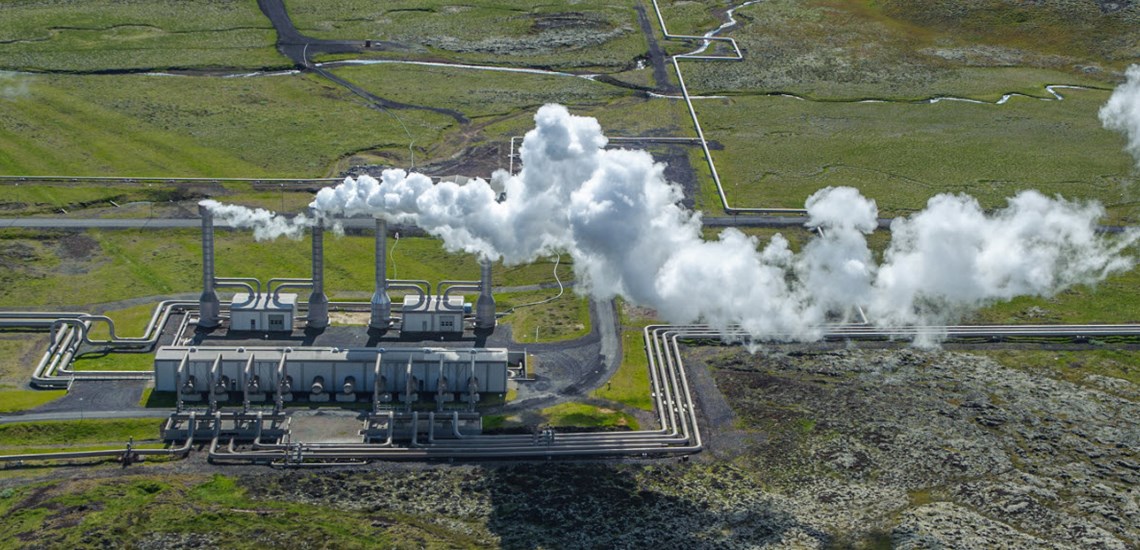Geothermal heat in Iceland

Iceland is located on the north Atlantic ridge, who runs through the island from the southwest through Reykjanes peninsula, through the center of the island and then north to Öxarfjörður fjord before disappearing back in to the North Atlantic ocean. Under Iceland is also a so-called hot spot where magma is pushing up in a large volume high up into the earth's crust. These factors, are the main reason for all the geothermal activity we have in Iceland.

This geothermal energy is all over the island, but most close to where we have the volcanic zones and the North Atlantic ridge going through the island. You can find many high-temperature geothermal areas as well as low temperature areas where hot water up wells from the ground.
Since the water is going down through non-condensing volcanic ground layers it comes into contact with hot rocks, it rises up through the same non-condensing laries and presses towards the ground again forming hot springs. In some places the water goes all the way to the surface, but in some places it is needed to drill down into the ground, sometimes just a few meters but elsewhere 1 to 2 km to reach the high temperature water and steam. The temperature in the boreholes is usually hot enough, it is more a matter of hitting a vein with enough water.
Bathing and heating Icelandic homes
This hot geothermal water has been used for a long time in Iceland, both for bathing and also for laundry, and thereby contribute to increasing the quality of life of the people in Iceland through the centuries.
Snorri Sturluson (1179 to 1241) writer and poet had a private geothermal pool called Snorralaug (laug, meaning geothermal pool) in Reykholt in Borgarfjörður and Grettir Sterki (Grettir the strong) living in Skagafjörður fjord, had a geothermal pool called Grettislaug. Both pools are still around, Snorralaug only for looking at but Grettislaug can be enjoyed by taking a bath and at the same time enjoying the view over Skagafjöður fjord and to Drangey island, great place to be during the bright summer nights in Iceland. Geothermal water in Laugardalur in Reykjavik was used to wash laundry in the old days.

In recent times, geothermal energy has played greater role for quality of life in Iceland and save a lot of imports of fossil fuels such as diesel and coal. Icelanders are of course still bathing in the hot natural geothermal pools, such as the hot geothermal river in Reykjadalur, Seljavallalaug geothermal pool, the geothermal pool in Landmannalaugar, Secret lagoon by Flúðir, Grettislaug geothermal pool and many others.
But geothermal energy is also used for heating, and over 90% of Icelandic homes are heated with geothermal water. Travelers often find the sulfat smell of the hot water coming from the tap, smell that tourists often feel rather bad, but no worries you will get use to it.

Producing electricity
In recent decades, geothermal energy has also been used in greater numbers to produce electricity. It is done by drilling deep boreholes on geothermal areas and high and low compressed geothermal steam that comes out of them used to turn turbines and produce electricity. Geothermal power plants like Svartsengi, Krafla, Hellisheiðarvirkjun, Nesjavellir, Reykjanesvirkjun and others have been build and are producing green, sustainable energy. Geothermal water is also use a lot for vegetables cultivated in Iceland, it is a cheap way to heat the greenhouses, giving us the change to cultivation of various vegetables that we could not grow otherwise.
There is a lot of research done on geothermal energy in Iceland and how best to use it for green and renewable resource in the most effective way for future generations. You can find many places in Iceland called Reykja- something or Reyk-something, Reykja or Reyk can mean geothermal steam.



